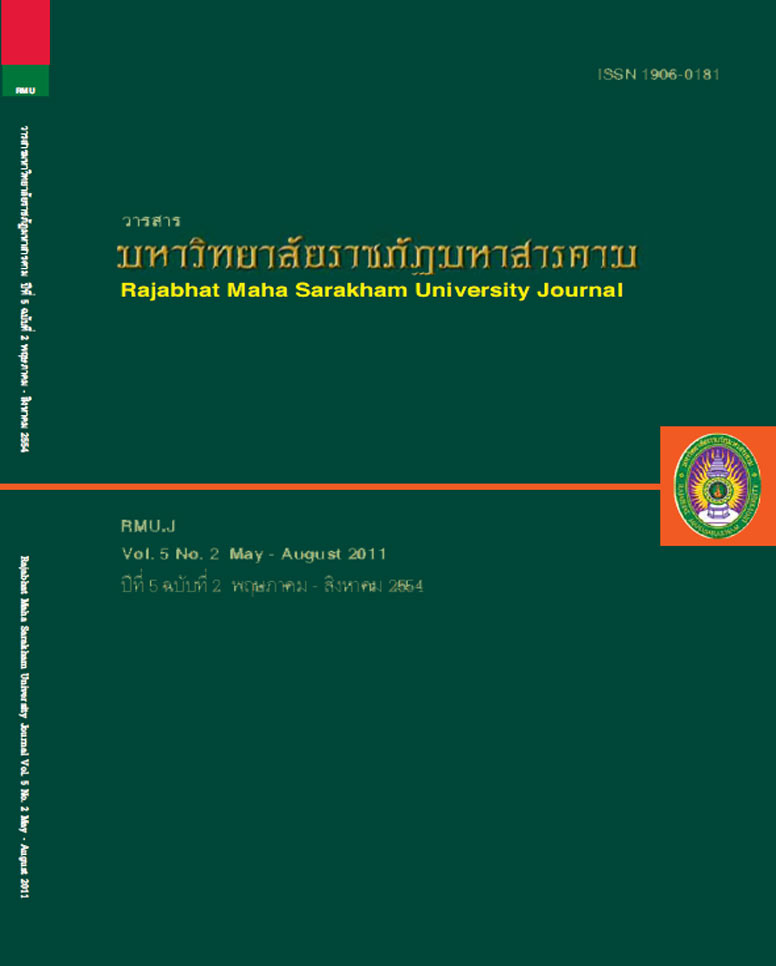การพัฒนารูปแบบฝึกอบรมการสร้างแบบทดสอบมาตรฐานวิชาชีพ; Developing a Training Model for Professional Standard Test Construction
Main Article Content
บทคัดย่อ
การวิจัยครั้งนี้ มีวัตถุประสงค์เพื่อพัฒนาและหาประสิทธิภาพรูปแบบฝึกอบรมการสร้างแบบทดสอบมาตรฐานวิชาชีพ
กลุ่มตัวอย่างเป็นอาจารย์ สอนในสาขาวิชาช่างอุตสาหกรรม วิทยาลัยเทคนิคพะเยา สังกัดสำนักงานคณะกรรมการ
การอาชีวศึกษา จำนวน 15 คน และมีการติดตามผลการสร้างและนำแบบทดสอบมาตรฐานวิชาชีพไปใช้ ภายหลัง
การฝึกอบรม 1 เดือน การประเมินผลหลักสูตรฝึกอบรมประยุกต์ใช้แบบจำลองแบบซิป (CIPP Model) ของ แดเนียล
แอล สตัฟเฟิลบีม ผลการวิจัยพบว่า
1. การประเมินสภาวะแวดล้อม หลักสูตรฝึกอบรมที่พัฒนาขึ้น ประกอบด้วย หัวข้อการอบรม จำนวน 5 หัวข้อหลัก
เป็นรูปแบบการฝึกอบรมเชิงปฏิบัติการ จำนวน 3 หัวข้อหลัก และฝึกอบรมด้วยเว็บฝึกอบรม 2 หัวข้อหลัก และหลักสูตรฝึกอบรม
มีความเหมาะสมกับผู้เข้าฝึกอบรมซึ่งเป็นครูผู้สอนวิชาชีพ
2. การประเมินปัจจัยเบื้องต้น ผู้เชี่ยวชาญมีความเห็นว่าหลักสูตรฝึกอบรมมีความเหมาะสมอยู่ในระดับมาก และ
ทุกองค์ประกอบของหลักสูตรฝึกอบรมมีความสอดคล้องกันสูง จากการนำไปใช้งาน พบว่า ประสิทธิภาพของหลักสูตรฝึกอบรม
ภาคทฤษฎีมีค่าเท่ากับ E1/E2 = 82.00/79.00 และภาคปฏิบัติเท่ากับร้อยละ 86.50 ซึ่งสูงกว่าเกณฑ์ที่กำหนด คะแนนผลสัมฤทธิ์
ด้านความรู้ของผู้เข้ารับการฝึกอบรมหลังฝึกอบรมสูงขึ้นกว่าก่อนฝึกอบรมอย่างมีนัยสำคัญทางสถิติที่ระดับ .01 ผลการประเมิน
การจัดฝึกอบรมในภาพรวม มีความเหมาะสมมาก ค่าความเชื่อมั่นของแบบฝึกหัดและแบบทดสอบ เท่ากับ 0.9200 และ 0.8815
เป็นไปตามเกณฑ์ที่กำหนด
3. การประเมินกระบวนการ ประสิทธิภาพของหลักสูตรฝึกอบรมภาคทฤษฎีมีค่าเท่ากับ E1/E2 = 81.82/80.19 และ
ภาคปฏิบัติเท่ากับร้อยละ 81.11 ซึ่งสูงกว่าเกณฑ์ที่กำหนดคะแนนผลสัมฤทธิ์ด้านความรู้ของผู้เข้ารับการฝึกอบรมหลังฝึกอบรม
สูงขึ้นกว่าก่อนฝึกอบรมอย่างมีนัยสำคัญทางสถิติที่ระดับ .01 ผลการประเมินการจัดฝึกอบรมในภาพรวมมีความเหมาะสมมาก
4. การประเมินผลผลิต (Product evaluation) ผลคะแนนการสร้างแบบทดสอบมาตรฐานวิชาชีพ เฉลี่ย 23.50 คะแนน
จาก 30 คะแนนซึ่งอยู่ในระดับดี การประเมินความคิดเห็นของผู้บังคับบัญชาในการนำเอาความรู้และทักษะที่ได้รับระหว่าง
การฝึกอบรมกลับไปประยุกต์ใช้กับงานมาใช้ในสถานศึกษาในระดับมาก
The purposes of this research were to develop and find the efficiency of a training model for
the professional standard test construction. The samples for this study were derived from the purposive
sampling technique consisting of 15 teachers from Phayao Technical College under the supervision of
Vocational Education Commission. The follow-up phase was implemented one month after the training.
The model evaluation was achieved by applying CIPP model of Danial L. Stuffebeam. The results
were as followed :1. Context Evaluation: The developed training model consisted of five main topics, three of
which were learned in a workshop and the other two were learned on the web. According to the experts,
the training model was appropriate to be used with vocational teachers.
2. Input Evaluation : The experts indicated that the appropriateness of the training curriculum and
the overall training course was high. The efficiency value of the training course for the theoretical part
was E1/E2 = 82.00/79.00 and 86.50% for the practical part which was higher than the set criteria.
The achievement tests pointed out that the trainees gained higher points in the post test than in the
pre-test showing the statistical significant difference at .01 level. Regarding the evaluation of the
training process, it was found that the training process as a whole was rated at the highest level.
The reliability values of the exercise and the tests were 0.9200 and 0.8815 respectively, corresponding
to the set criteria.
3. Process Evaluation: The efficiency value of the training course was E1/E2 = 81.82 /80.19
for the theoretical part and 81.11% for the practical part which was higher than the set criteria. The
achievement tests pointed out that the trainees gained higher points in the post test than in the pre-test
showing the statistical significant difference at .01 level. As a whole, the training program was rated
appropriate at the high level.
4. Product Evaluation: The average points of the professional standard test was 23.50 out of 30
which was at the ‘good’ level. According to the supervisors, the knowledge and skills that the trainees
obtained from the training program could be applied to the workplaces at the high level
Article Details
1. บทความที่ลงตีพิมพ์ทุกเรื่องได้รับการตรวจทางวิชาการโดยผู้ประเมินอิสระ ผู้ทรงคุณวุฒิ (Peer Review) สาขาที่เกี่ยวข้อง อย่างน้อย 3 ท่าน ในรูปแบบ Double blind review
2. ข้อคิดเห็นใด ๆ ของบทความที่ลงตีพิมพ์ในวารสารมหาวิทยาลัยราชภัฏมหาสารคาม นี้เป็นของผู้เขียน คณะผู้จัดทำวารสารไม่จำเป็นต้องเห็นด้วย
3. กองบรรณาธิการวารสารมหาวิทยาลัยราชภัฏมหาสารคาม ไม่สงวนสิทธิ์การคัดลอกแต่ให้อ้างอิงแสดงที่มา


